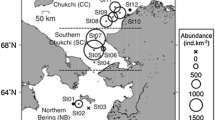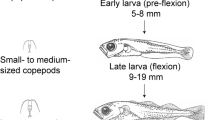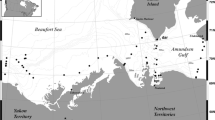Abstract
Diet investigations were carried out on 0-, 1- and 2-year-old Northeast Arctic cod (Gadus morhua) sampled in the Barents Sea during 1984–2002. Stomach-content analyses showed that the 0 and 1 group cod fed mainly on crustaceans, with krill and amphipods composing up to 70% of their diet. Krill (Thysanoessa spp. and Meganyctiphanes norvegica) and amphipods (Themisto spp.) were mainly found in cod stomachs sampled in the central and close to the Polar Front region in the Barents Sea where these prey organisms are reported to be abundant in summer. A shift in the main diet from crustaceans to fish was observed from age 1 to age 2. The diet of 2-year-old cod mainly comprised capelin (Mallotus villosus) and other fish, and to a lesser degree, krill and amphipods. Shrimp (mainly Pandalus spp.) was also an important prey in both age 1 and 2 cod. A statistically significant positive relationship was obtained between capelin stock size and the amount of capelin in the diet of 2-year-old cod. Results from this study also show that the larger age-2 cod preyed more on capelin in winter and that larger cod (>22 cm) prefer larger capelin (>12 cm). During periods of low capelin abundance, the 2-year-old cod shift their diet more to crustaceans, such as krill and amphipods. A positive significant relationship was also obtained between Total Fullness Index (TFI) and the amount of capelin in the diet and between TFI and the growth of 2-year-old cod, indicating that the growth of age-2 cod is to a large extent dependent on the amount of capelin consumed. Growth of age-1 cod was also positively correlated to TFI.













Similar content being viewed by others
References
Ådlandsvik B, Loeng H (1991) A study of the climatic system in the Barents Sea. In: Sakshaug E, Hopkins CCE, Øritsland NA (eds) Proceedings of the Pro Mare Symposium on Polar Marine Ecology, Trondheim, 12–16 May 1990. Polar Res 10:45–49
Aschan M, Sunnanå K (1997) Evaluation of the Norwegian Shrimp Survey in the Barents Sea and the Svalbard area 1980–1997. ICES CM 1997/Y:07
Asthorsson OS, Pálsson ÓK (1987) Predation on euphausiids by cod, Gadus morhua, in winter in Icelandic subarctic waters. Mar Biol 96:327–334
Bogstad B, Gjøsaeter H (2001) Predation by cod (Gadus morhua) on capelin (Mallotus villosus) in the Barents Sea: implications for capelin stock assessment. Fish Res 53:197–209
Bogstad B, Mehl S (1997) Interactions between Atlantic cod (Gadus morhua) and its prey species in the Barents Sea. Forage Fishes in Marine Ecosystems. Alaska Sea Grant College program, AK-SG-97-01, pp 591–615
Bogstad B, Lilly GR, Mehl S, Pálsson ÓK, Stefánsson G (1994) Cannibalism and year-class strength in Atlantic cod (Gadus morhua L.) in Arcto-boreal ecosystems (Barents Sea, Iceland and eastern Newfoundland). ICES Mar Sci Symp 198:576–599
Dalpadado P, Skjoldal HR (1996) Abundance, maturity and growth of the krill species, Thysanoessa inermis and T. longicaudata in the Barents Sea. Mar Ecol Prog Ser 144:175–183
Dalpadado P, Borkner N, Bogstad B, Mehl S (2001) Distribution of Themisto (Amphipoda) spp. in the Barents Sea and predator-prey interactions. ICES J Mar Sci 58:876–895
Dalpadado P, Bogstad B, Gjøsaeter H, Mehl S, Skjoldal HR (2002) Zooplankton-fish interactions in the Barents Sea. In: Sherman K, Skjoldal HR (eds) Large marine ecosystems of the North Atlantic. Elsevier, Amsterdam, pp 269–291
Dalpadado P, Ingvaldsen R, Hassel A (2003) Zooplankton biomass variation in relation to climatic conditions in the Barents Sea. Polar Biol 26:233–241
Drobysheva S, Nesterova V, Zhukova N (2003) Abundance dynamics of the Barents Sea euphausiids and their importance as a component of cod food supply. WD4, ICES Arctic Fisheries Working Group, San Sebastian, Spain 23 April–2 May 2003
Fahrig L, Lilly GR, Miller DS (1993) Predator stomachs as sampling tools for prey distribution: Atlantic cod (Gadus morhua) and capelin (Mallotus villosus). Can J Fish Aquat Sci 50:1541–1547
Frøysa KG, Bogstad B, Skagen DW (2002) Fleksibest—an age-length structured fish stock assessment tool with application to Northeast Arctic cod (Gadus morhua L.). Fish Res 55:87–101
Gjøsaeter H (1998) The population biology and exploitation of capelin (Mallotus villosus) in the Barents Sea. Sarsia 83:453–496
Gjøsaeter H, Bogstad B (1998) Effects of the presence of herring on the stock-recruitment relationship of Barents Sea capelin (Mallotus villosus). Fish Res 38:57–71
Gjøsaeter H, Dommasnes A, Røttingen B (1998) The Barents Sea capelin stock 1972–1997. A synthesis of results from acoustic surveys. Sarsia 83:497–510
Gjøsaeter H, Dalpadado P, Hassel A, Skjoldal HR (2000) A comparison of performance of WP2 and MOCNESS. J Plankton Res 22:1901–1908
Gjøsaeter H, Bogstad B, Tjelmeland S (2002a) Assessment methodology for Barents Sea capelin (Mallotus villosus Müller). ICES J Mar Sci 59:1086–1095
Gjøsaeter H, Dalpadado P, Hassel A (2002b) Growth of Barents Sea capelin (Mallotus villosus Müller) in relation to zooplankton abundance. ICES J Mar Sci 59:959–967
Helle K, Pennington M, Bogstad B, Ottersen G (2002) Some environmental factors that influence the growth of Arcto-Norwegian cod from the early juvenile to the adult stage. Environ Biol Fish 65:341–348
ICES (2003a) Report of the Arctic Fisheries Working Group, San Sebastian, 23 April—2 May 2003. ICES CM 2003/ACFM:22
ICES (2003b) Report of the Northern Pelagic and Blue Whiting Fisheries Working Group, Copenhagen, 29 April-8 May 2003. ICES CM 2003/ACFM:23
Ingvaldsen R, Loeng H, Ottersen G, Ådlandsvik B (2003) Climate variability in the Barents Sea during the 20th century with a focus on the 1990s. ICES Mar Sci Symp 219:160–168
Jakobsen T, Korsbrekke K, Mehl S, Nakken O (1997) Norwegian combined acoustic and bottom trawl surveys for demersal fish in the Barents Sea during winter. ICES CM 1997/Y:17
Jangaard PM (1974) The capelin (Mallotus villosus). Biology, distribution, exploitation, utilization and composition. Bulletin 186:1–70
Johansen GO (2002) Temporal and spatial variation in predation on juvenile herring (Clupea harengus L.) by Northeast Arctic cod (Gadus morhua L.) in the Barents Sea in 1984–1997. ICES J Mar Sci 59:270–292
Johansen GO (2003) Size-dependent predation on juvenile herring (Clupea harengus L.) by North-east Arctic cod (Gadus morhua L.) in the Barents Sea. Sarsia 88:136–153
Lepesevich YuM, Shevelev MS (1997) Evolution of the Russian survey for demersal fish: from ideal to reality. ICES CM 1997/Y:09
Lilly GR (1991) Interannual variability in predation by cod (Gadus morhua) on capelin (Mallotus villosus) and other prey off southern Labrador and northeastern Newfoundland. ICES Mar Sci Symp 193:133–146
Lilly GR, Fleming AM (1981) Size relationships in predation by Atlantic cod, Gadus morhua, on capelin, Mallotus villosus, and sand lance, Ammodytes dubius, in the Newfoundland area. NAFO Sci Counc Stud 1:41–45
Magnússon KG, Pálsson ÓK (1989) Trophic ecological relationships of Icelandic cod. Rapp PV Réun Cons Int Explor Mer 188:206–224
Mehl S, Yaragina NA (1992) Methods and results in the joint PINRO-IMR stomach sampling program. In: Bogstad B, Tjelmeland S (eds) Interrelations between fish populations in the Barents Sea. Proceedings of the 5th PINRO-IMR Symposium, Murmansk 12–16th August 1991. Institute of Marine Research, Bergen, pp 5–16
Michalsen K, Ottersen G, Nakken O (1998) Growth of North-east Arctic cod (Gadus morhua L.) in relation to ambient temperature. ICES J Mar Sci 55:863–877
Nakken O, Raknes A (1987) The distribution and growth of Northeast Arctic cod in relation to bottom temperatures in the Barents Sea, 1978–1984. Fish Res 5:243–252
Ottersen G, Michalsen K, Nakken O (1998) Ambient temperature and distribution of north-east Arctic cod. ICES J Mar Sci 55:67–85
Ottersen G, Helle K, Bogstad B (2002) Do abiotic mechanisms determine interannual variability in length-at-age of juvenile Arcto-Norwegian cod? Can J Fish Aquat Sci 59:57–65
Pálsson ÓK (1994) A review of the trophic interactions of cod stocks in the North Atlantic. ICES Mar Sci Symp 198:553–575
PINRO (1996) The Barents Sea cod (biological and fisheries outline). By Boitsov VD, Lebed NI, Ponomarenko VP, Ponomarenko IYa, Tereshchenko VV, Tretyak VL, Shevelev MS, Yaragina NA. PINRO, Murmansk. In Russian
Ponomarenko IYa, Yaragina NA (1979) Seasonal and year to year variations in the feeding of the Barents Sea cod on the Euphausiacea in 1947–1977. ICES CM 1979/G:17
Santos J dos, Jobling M (1995) Test of a food consumption model for the Atlantic cod. ICES J Mar Sci 52:209–219
Skjoldal HR, Rey F (1989) Pelagic production and variability of the Barents Sea Ecosystem: In: Sherman K, Alexander L (eds) Biomass yields and geography of large marine ecosystems. AAAS Selected Symposium, pp 173–186
Steele DH, Lilly GR (1999) Predation by cod (Gadus morhua) on amphipod crustaceans in the Northwestern Atlantic. Vie Milieu 49:309–316
Tereshchenko VV (1996) Seasonal and year-to-year variations of temperature and salinity along the Kola meridian transect. ICES CM 1996/C:11
Tjelmeland S, Bogstad B (1993) The Barents Sea capelin stock collapse: a lesson to learn. In: Smith SJ, Hunt JJ, Rivard D (eds) Risk evaluation and biological reference points for fisheries management. Can Spec Publ Fish Aquat Sci 120:127–139
Yaragina NA, Marshall CT (2000) Trophic influences on interannual and seasonal variation in the liver condition index of Northeast Arctic cod (Gadus morhua). ICES J Mar Sci 57:42–55
Acknowledgements
Financial support for this study has been provided by two EU projects: (1) The Barents Region: Linking Arctic Natural resources, climate change and Economics (BALANCE) EVK2-2001-00369, and (2) Development of structurally detailed statistically testable models of marine populations (dst2) QLK5-CT1999-01609. This project is placed under the research program “Climate and Fish” at the Institute of Marine Research, Bergen, Norway. We thank PINRO (Murmansk, Russia) for kindly providing the temperature data from the Kola section from 1995–2002. We would also like to thank Dr. Philip Reid and one anonymous referee for their constructive comments on the manuscript.
Author information
Authors and Affiliations
Corresponding author
Rights and permissions
About this article
Cite this article
Dalpadado, P., Bogstad, B. Diet of juvenile cod (age 0–2) in the Barents Sea in relation to food availability and cod growth. Polar Biol 27, 140–154 (2004). https://doi.org/10.1007/s00300-003-0561-5
Received:
Accepted:
Published:
Issue Date:
DOI: https://doi.org/10.1007/s00300-003-0561-5




